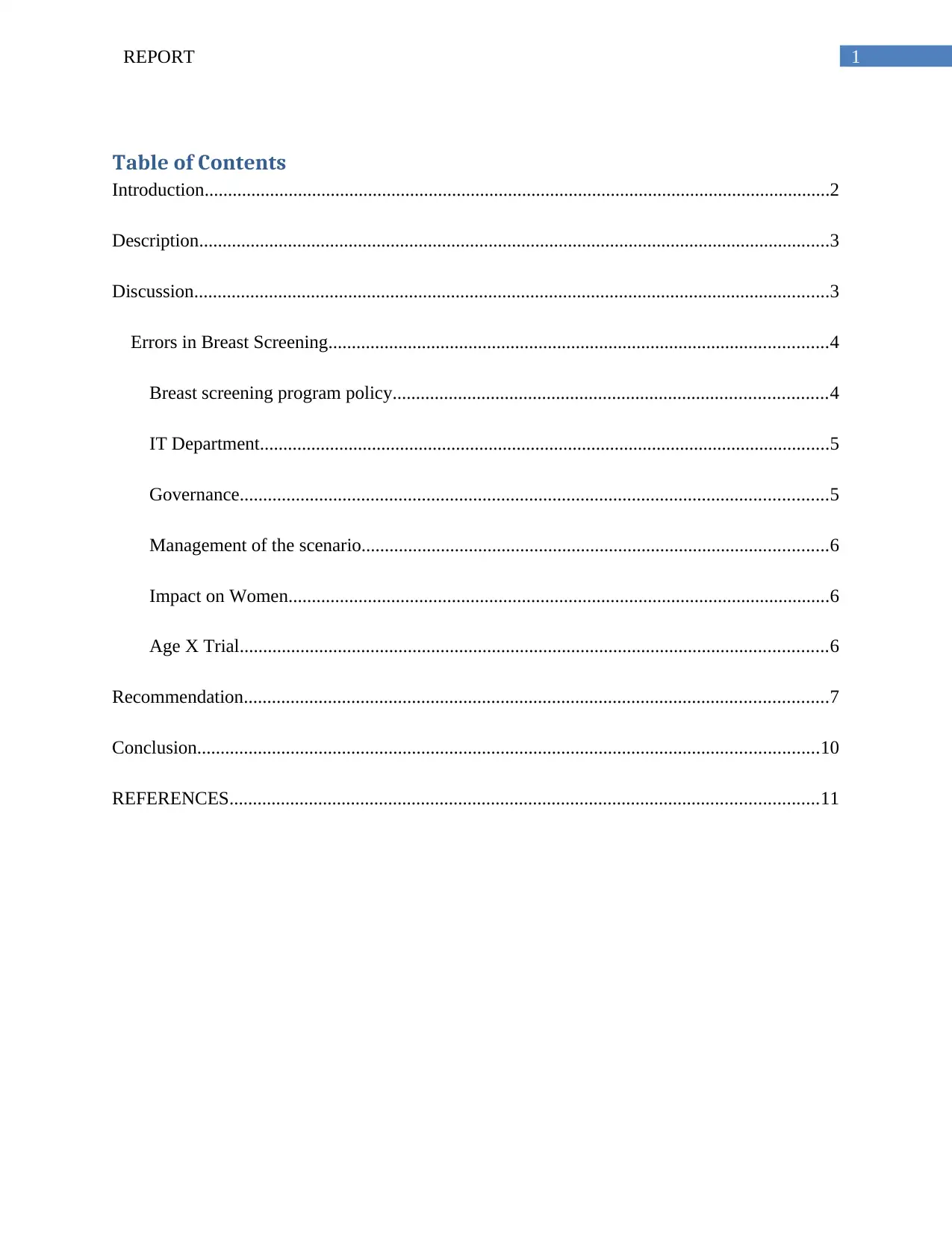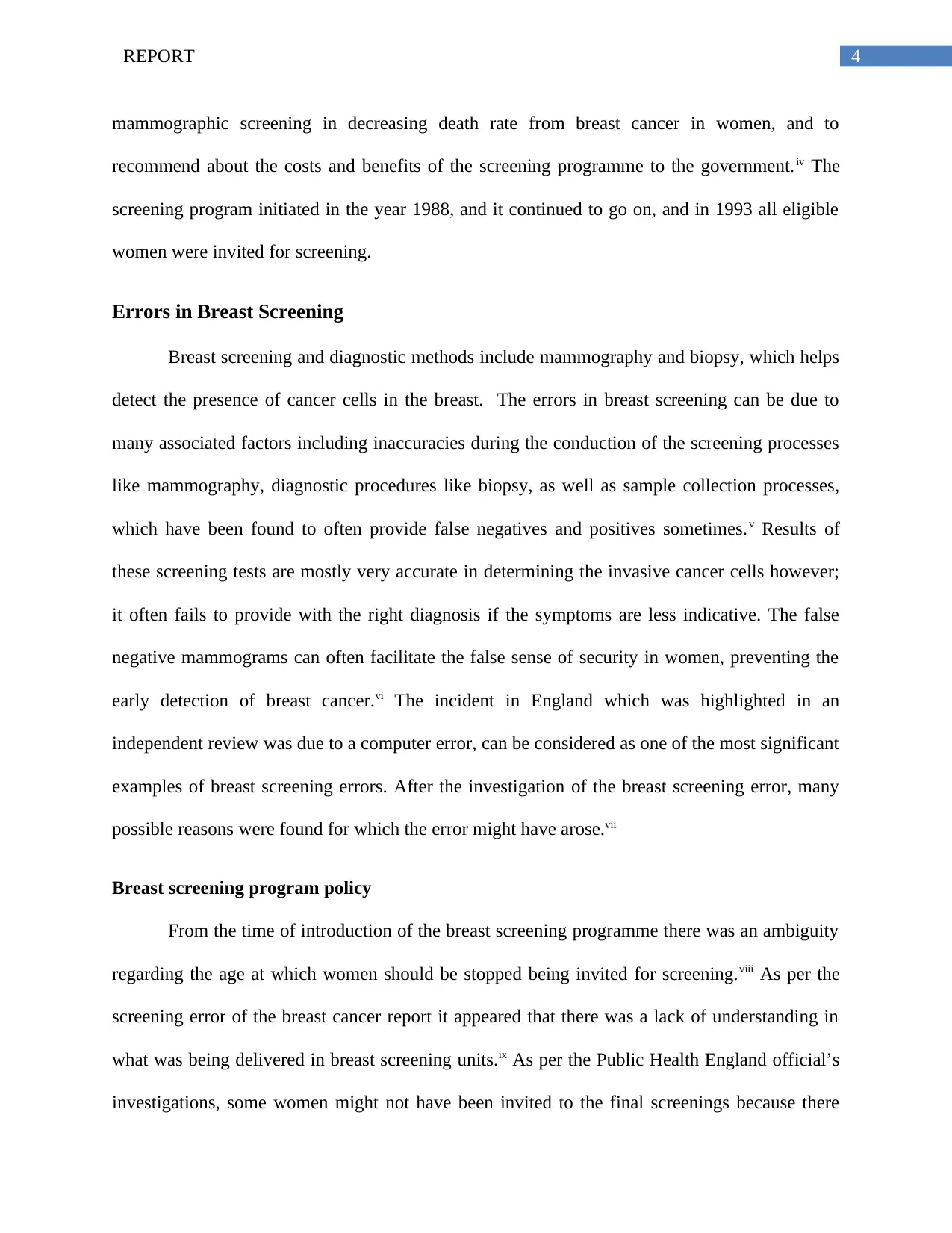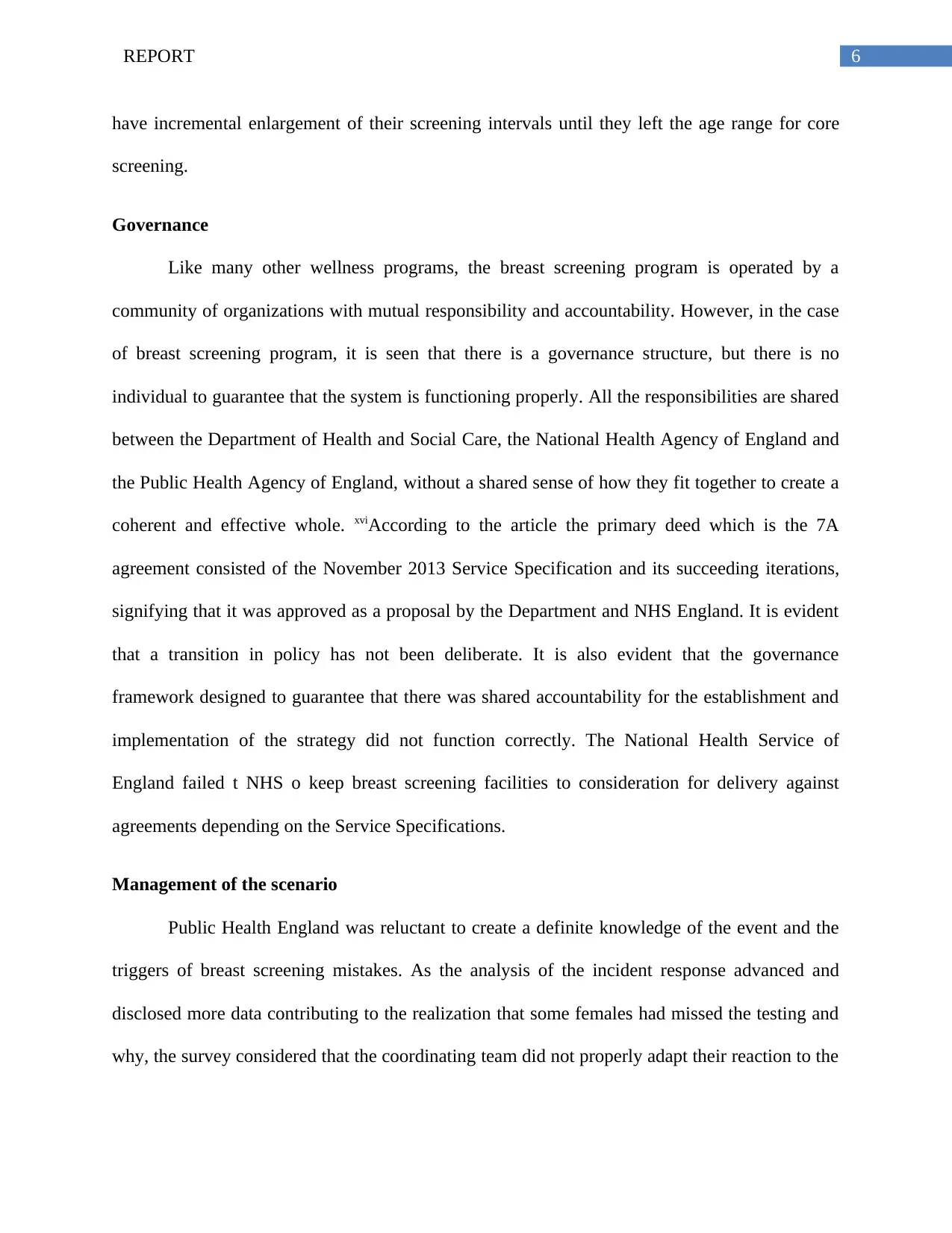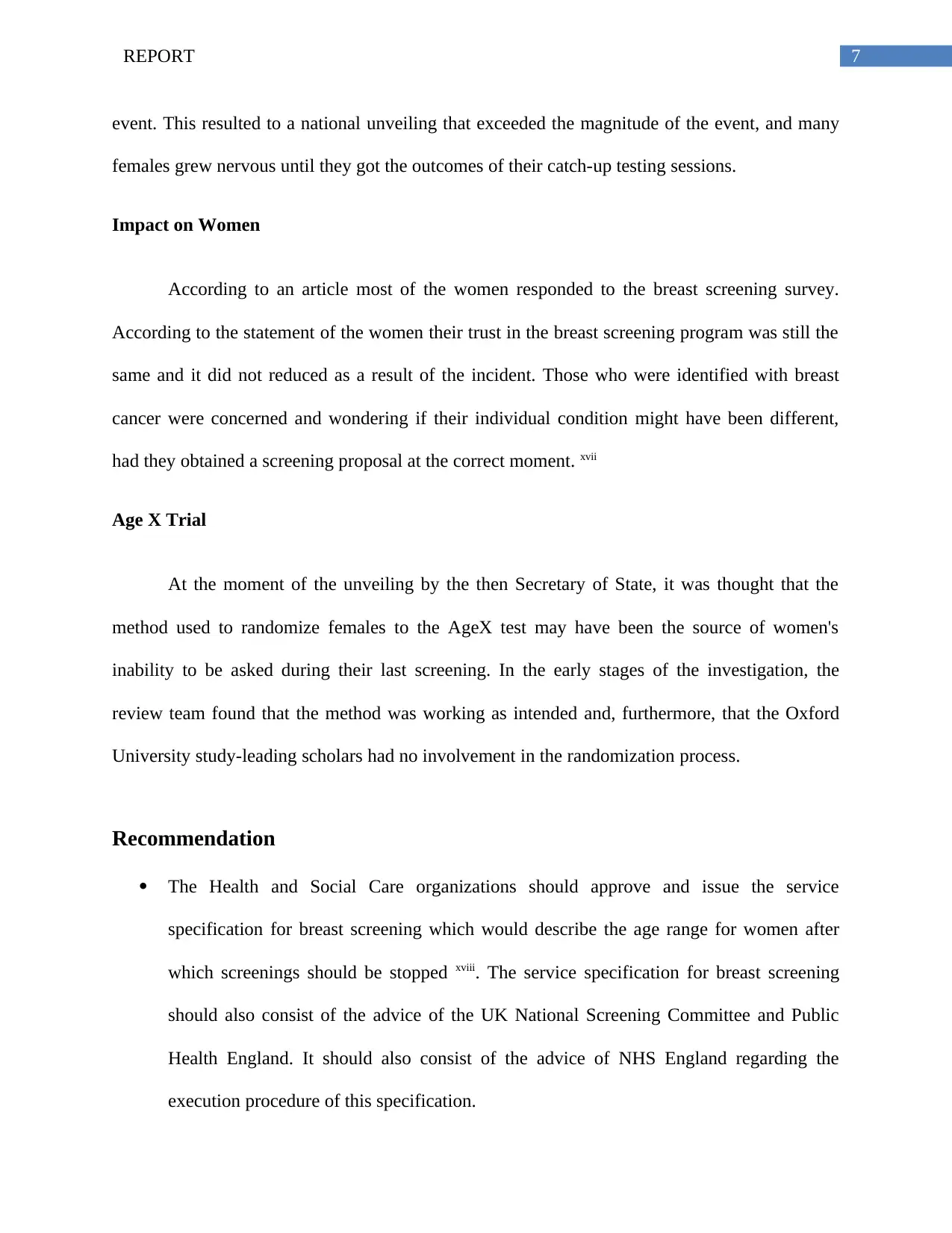Macquarie University Case Study Report: Breast Screening Error
VerifiedAdded on 2022/10/06
|15
|2480
|21
Report
AI Summary
This report analyzes a significant breast screening error in England, where approximately 450,000 older women were not invited for mammography screenings due to IT system failures and age parameter discrepancies. The report details the errors, including the potential impact on women's health and life expectancy. It examines the role of Public Health England, the IT department, and governance structures in the incident. The analysis identifies the main issues, such as ambiguities in screening policies and IT system complexities. The report also investigates the Age X trial and its connection to the error. Finally, it provides several recommendations, including the need for clear service specifications, improved IT system integration, enhanced governance procedures, and better communication with the public, to prevent similar errors from recurring in the future. The report emphasizes the need for a cohesive and effective approach across various organizations involved in breast screening programs.

Running head: REPORT
Report
Name of the student
Name of the university
Author’s name
Report
Name of the student
Name of the university
Author’s name
Paraphrase This Document
Need a fresh take? Get an instant paraphrase of this document with our AI Paraphraser

1REPORT
Table of Contents
Introduction......................................................................................................................................2
Description.......................................................................................................................................3
Discussion........................................................................................................................................3
Errors in Breast Screening...........................................................................................................4
Breast screening program policy.............................................................................................4
IT Department..........................................................................................................................5
Governance..............................................................................................................................5
Management of the scenario....................................................................................................6
Impact on Women....................................................................................................................6
Age X Trial..............................................................................................................................6
Recommendation.............................................................................................................................7
Conclusion.....................................................................................................................................10
REFERENCES..............................................................................................................................11
Table of Contents
Introduction......................................................................................................................................2
Description.......................................................................................................................................3
Discussion........................................................................................................................................3
Errors in Breast Screening...........................................................................................................4
Breast screening program policy.............................................................................................4
IT Department..........................................................................................................................5
Governance..............................................................................................................................5
Management of the scenario....................................................................................................6
Impact on Women....................................................................................................................6
Age X Trial..............................................................................................................................6
Recommendation.............................................................................................................................7
Conclusion.....................................................................................................................................10
REFERENCES..............................................................................................................................11

2REPORT
Introduction
In the year 2009, Public Health England found anomalies in the analyzed data from the
age X trial, where it was seen that around 450,000 women of old age around 68-70 were not
invited in a NHS mammography screenings.i The reason behind this cause was not particular as
there was no particular information on the issue, though there were two possible reasons – failure
in the IT system and there could have been a cut-off at age 70, and not 71, thereby excluding
women who had not yet reached their 71st birthday and should have been included. According to
Jeremy Hunt the health secretary, among 135 and 270 women might have reduced their life
duration as a consequence. The primary purpose of the case study is to identify the main issues
for which the error has occurred and to mention recommendations for the following problems to
prevent them from reoccurring in the future.
Introduction
In the year 2009, Public Health England found anomalies in the analyzed data from the
age X trial, where it was seen that around 450,000 women of old age around 68-70 were not
invited in a NHS mammography screenings.i The reason behind this cause was not particular as
there was no particular information on the issue, though there were two possible reasons – failure
in the IT system and there could have been a cut-off at age 70, and not 71, thereby excluding
women who had not yet reached their 71st birthday and should have been included. According to
Jeremy Hunt the health secretary, among 135 and 270 women might have reduced their life
duration as a consequence. The primary purpose of the case study is to identify the main issues
for which the error has occurred and to mention recommendations for the following problems to
prevent them from reoccurring in the future.
⊘ This is a preview!⊘
Do you want full access?
Subscribe today to unlock all pages.

Trusted by 1+ million students worldwide

3REPORT
Description
According to Public Health England (PHE), the screening programme detects around
18,400 cancers each year and saves 1300 lives. Annually around 350,000 women receive
invitations for screening, but since last nine years, there has been a short of 50 000 women per
year. According to PHE, of the 450,000 women who were not invited for screening, 309,000 are
still alive. The reason behind this issue was not properly determined as there was no particular
information on the issue, though there were two possible reasons identified – failure in the IT
system and there could have been a cut-off at age 70, and not 71, thereby excluding women who
had not yet reached their 71st birthday and should have been included. Public Health England
has determined to help the 309,000 women who are still alive. According to the PHE all women
of age 72, who are registered with a GP, can expect to get an appointment by the end of May
month.ii
Discussion
Breast cancer is a kind of cancer that occurs in the breast cells, where these cells undergo
abnormal rapid multiplications compared to the healthy cells. These cancerous cells as a result
accumulate forming a mass or lump in the breast tissues, especially in the milking ducts or
glandular breast tissues. The cancer cells cover the lobules or the ducts of the breasts. The lump
or tumor is considered malignant, when the cells invade surrounding tissues and healthy cells.iii
According to some researches around 9 out of 10 women get breast cancer surviving for five
years or more. In the year 1985, Professor Sir Patrick Forrest was ordered by the then Minister of
State for Health, the Rt Hon Kenneth Clarke MP, to make an evaluation of the efficacy of
Description
According to Public Health England (PHE), the screening programme detects around
18,400 cancers each year and saves 1300 lives. Annually around 350,000 women receive
invitations for screening, but since last nine years, there has been a short of 50 000 women per
year. According to PHE, of the 450,000 women who were not invited for screening, 309,000 are
still alive. The reason behind this issue was not properly determined as there was no particular
information on the issue, though there were two possible reasons identified – failure in the IT
system and there could have been a cut-off at age 70, and not 71, thereby excluding women who
had not yet reached their 71st birthday and should have been included. Public Health England
has determined to help the 309,000 women who are still alive. According to the PHE all women
of age 72, who are registered with a GP, can expect to get an appointment by the end of May
month.ii
Discussion
Breast cancer is a kind of cancer that occurs in the breast cells, where these cells undergo
abnormal rapid multiplications compared to the healthy cells. These cancerous cells as a result
accumulate forming a mass or lump in the breast tissues, especially in the milking ducts or
glandular breast tissues. The cancer cells cover the lobules or the ducts of the breasts. The lump
or tumor is considered malignant, when the cells invade surrounding tissues and healthy cells.iii
According to some researches around 9 out of 10 women get breast cancer surviving for five
years or more. In the year 1985, Professor Sir Patrick Forrest was ordered by the then Minister of
State for Health, the Rt Hon Kenneth Clarke MP, to make an evaluation of the efficacy of
Paraphrase This Document
Need a fresh take? Get an instant paraphrase of this document with our AI Paraphraser

4REPORT
mammographic screening in decreasing death rate from breast cancer in women, and to
recommend about the costs and benefits of the screening programme to the government.iv The
screening program initiated in the year 1988, and it continued to go on, and in 1993 all eligible
women were invited for screening.
Errors in Breast Screening
Breast screening and diagnostic methods include mammography and biopsy, which helps
detect the presence of cancer cells in the breast. The errors in breast screening can be due to
many associated factors including inaccuracies during the conduction of the screening processes
like mammography, diagnostic procedures like biopsy, as well as sample collection processes,
which have been found to often provide false negatives and positives sometimes.v Results of
these screening tests are mostly very accurate in determining the invasive cancer cells however;
it often fails to provide with the right diagnosis if the symptoms are less indicative. The false
negative mammograms can often facilitate the false sense of security in women, preventing the
early detection of breast cancer.vi The incident in England which was highlighted in an
independent review was due to a computer error, can be considered as one of the most significant
examples of breast screening errors. After the investigation of the breast screening error, many
possible reasons were found for which the error might have arose.vii
Breast screening program policy
From the time of introduction of the breast screening programme there was an ambiguity
regarding the age at which women should be stopped being invited for screening.viii As per the
screening error of the breast cancer report it appeared that there was a lack of understanding in
what was being delivered in breast screening units.ix As per the Public Health England official’s
investigations, some women might not have been invited to the final screenings because there
mammographic screening in decreasing death rate from breast cancer in women, and to
recommend about the costs and benefits of the screening programme to the government.iv The
screening program initiated in the year 1988, and it continued to go on, and in 1993 all eligible
women were invited for screening.
Errors in Breast Screening
Breast screening and diagnostic methods include mammography and biopsy, which helps
detect the presence of cancer cells in the breast. The errors in breast screening can be due to
many associated factors including inaccuracies during the conduction of the screening processes
like mammography, diagnostic procedures like biopsy, as well as sample collection processes,
which have been found to often provide false negatives and positives sometimes.v Results of
these screening tests are mostly very accurate in determining the invasive cancer cells however;
it often fails to provide with the right diagnosis if the symptoms are less indicative. The false
negative mammograms can often facilitate the false sense of security in women, preventing the
early detection of breast cancer.vi The incident in England which was highlighted in an
independent review was due to a computer error, can be considered as one of the most significant
examples of breast screening errors. After the investigation of the breast screening error, many
possible reasons were found for which the error might have arose.vii
Breast screening program policy
From the time of introduction of the breast screening programme there was an ambiguity
regarding the age at which women should be stopped being invited for screening.viii As per the
screening error of the breast cancer report it appeared that there was a lack of understanding in
what was being delivered in breast screening units.ix As per the Public Health England official’s
investigations, some women might not have been invited to the final screenings because there

5REPORT
was a confusion regarding the entitlement.x The resolution to base the response of the event on
the policy as set out in the November 2013 Service Specification was taken on internal legal
advice, but without the understanding of the specification which did not align with the
procedures and practice in breast screening units.xi
The ambiguity should have been made clear during the early phase of the programme,
and assessments should have been done regarding the consistency across the country. In 2013
when programme was split among the Department of Health, Public Health England and NHS
England, service specifications were recorded in an attempt to address the uncertaintyxii.
However, an attempt to clarify the uncertainty was late and incorrect as, those accountable for
ensuring the specification and the governance structures put in place to assure the specification
did not notice and identify the mistake. (Asri, Mousannif, Al Moatassime, Noel, 2016). This
created a lack of security in women, mainly due to the false negatives and false positives. xiii
IT Department
Breast cancer screening consists of specialized imaging tools, utilized by trained
specialists mammographers and radiographers.xiv During the breast screening procedures, women
from the surrounding area who have registered with a GP and are of specific age range are called
in batches, for to be screened. To create the batches used to invite women, breast screening units
use two IT systems: the National Breast Screening Services (NBSS); and Breast Screening Select
(BS-Select). According to the Independent Breast Screening Review 2018, around 5,000 women
were not called to their breast cancer screening procedures.xv As per the review this did not
happen because of any systemic IT error but it occurred because of the usage of two different
and complex systems and blunders in the screenings done by the unit staffs. These led women
was a confusion regarding the entitlement.x The resolution to base the response of the event on
the policy as set out in the November 2013 Service Specification was taken on internal legal
advice, but without the understanding of the specification which did not align with the
procedures and practice in breast screening units.xi
The ambiguity should have been made clear during the early phase of the programme,
and assessments should have been done regarding the consistency across the country. In 2013
when programme was split among the Department of Health, Public Health England and NHS
England, service specifications were recorded in an attempt to address the uncertaintyxii.
However, an attempt to clarify the uncertainty was late and incorrect as, those accountable for
ensuring the specification and the governance structures put in place to assure the specification
did not notice and identify the mistake. (Asri, Mousannif, Al Moatassime, Noel, 2016). This
created a lack of security in women, mainly due to the false negatives and false positives. xiii
IT Department
Breast cancer screening consists of specialized imaging tools, utilized by trained
specialists mammographers and radiographers.xiv During the breast screening procedures, women
from the surrounding area who have registered with a GP and are of specific age range are called
in batches, for to be screened. To create the batches used to invite women, breast screening units
use two IT systems: the National Breast Screening Services (NBSS); and Breast Screening Select
(BS-Select). According to the Independent Breast Screening Review 2018, around 5,000 women
were not called to their breast cancer screening procedures.xv As per the review this did not
happen because of any systemic IT error but it occurred because of the usage of two different
and complex systems and blunders in the screenings done by the unit staffs. These led women
⊘ This is a preview!⊘
Do you want full access?
Subscribe today to unlock all pages.

Trusted by 1+ million students worldwide

6REPORT
have incremental enlargement of their screening intervals until they left the age range for core
screening.
Governance
Like many other wellness programs, the breast screening program is operated by a
community of organizations with mutual responsibility and accountability. However, in the case
of breast screening program, it is seen that there is a governance structure, but there is no
individual to guarantee that the system is functioning properly. All the responsibilities are shared
between the Department of Health and Social Care, the National Health Agency of England and
the Public Health Agency of England, without a shared sense of how they fit together to create a
coherent and effective whole. xviAccording to the article the primary deed which is the 7A
agreement consisted of the November 2013 Service Specification and its succeeding iterations,
signifying that it was approved as a proposal by the Department and NHS England. It is evident
that a transition in policy has not been deliberate. It is also evident that the governance
framework designed to guarantee that there was shared accountability for the establishment and
implementation of the strategy did not function correctly. The National Health Service of
England failed t NHS o keep breast screening facilities to consideration for delivery against
agreements depending on the Service Specifications.
Management of the scenario
Public Health England was reluctant to create a definite knowledge of the event and the
triggers of breast screening mistakes. As the analysis of the incident response advanced and
disclosed more data contributing to the realization that some females had missed the testing and
why, the survey considered that the coordinating team did not properly adapt their reaction to the
have incremental enlargement of their screening intervals until they left the age range for core
screening.
Governance
Like many other wellness programs, the breast screening program is operated by a
community of organizations with mutual responsibility and accountability. However, in the case
of breast screening program, it is seen that there is a governance structure, but there is no
individual to guarantee that the system is functioning properly. All the responsibilities are shared
between the Department of Health and Social Care, the National Health Agency of England and
the Public Health Agency of England, without a shared sense of how they fit together to create a
coherent and effective whole. xviAccording to the article the primary deed which is the 7A
agreement consisted of the November 2013 Service Specification and its succeeding iterations,
signifying that it was approved as a proposal by the Department and NHS England. It is evident
that a transition in policy has not been deliberate. It is also evident that the governance
framework designed to guarantee that there was shared accountability for the establishment and
implementation of the strategy did not function correctly. The National Health Service of
England failed t NHS o keep breast screening facilities to consideration for delivery against
agreements depending on the Service Specifications.
Management of the scenario
Public Health England was reluctant to create a definite knowledge of the event and the
triggers of breast screening mistakes. As the analysis of the incident response advanced and
disclosed more data contributing to the realization that some females had missed the testing and
why, the survey considered that the coordinating team did not properly adapt their reaction to the
Paraphrase This Document
Need a fresh take? Get an instant paraphrase of this document with our AI Paraphraser

7REPORT
event. This resulted to a national unveiling that exceeded the magnitude of the event, and many
females grew nervous until they got the outcomes of their catch-up testing sessions.
Impact on Women
According to an article most of the women responded to the breast screening survey.
According to the statement of the women their trust in the breast screening program was still the
same and it did not reduced as a result of the incident. Those who were identified with breast
cancer were concerned and wondering if their individual condition might have been different,
had they obtained a screening proposal at the correct moment. xvii
Age X Trial
At the moment of the unveiling by the then Secretary of State, it was thought that the
method used to randomize females to the AgeX test may have been the source of women's
inability to be asked during their last screening. In the early stages of the investigation, the
review team found that the method was working as intended and, furthermore, that the Oxford
University study-leading scholars had no involvement in the randomization process.
Recommendation
The Health and Social Care organizations should approve and issue the service
specification for breast screening which would describe the age range for women after
which screenings should be stopped xviii. The service specification for breast screening
should also consist of the advice of the UK National Screening Committee and Public
Health England. It should also consist of the advice of NHS England regarding the
execution procedure of this specification.
event. This resulted to a national unveiling that exceeded the magnitude of the event, and many
females grew nervous until they got the outcomes of their catch-up testing sessions.
Impact on Women
According to an article most of the women responded to the breast screening survey.
According to the statement of the women their trust in the breast screening program was still the
same and it did not reduced as a result of the incident. Those who were identified with breast
cancer were concerned and wondering if their individual condition might have been different,
had they obtained a screening proposal at the correct moment. xvii
Age X Trial
At the moment of the unveiling by the then Secretary of State, it was thought that the
method used to randomize females to the AgeX test may have been the source of women's
inability to be asked during their last screening. In the early stages of the investigation, the
review team found that the method was working as intended and, furthermore, that the Oxford
University study-leading scholars had no involvement in the randomization process.
Recommendation
The Health and Social Care organizations should approve and issue the service
specification for breast screening which would describe the age range for women after
which screenings should be stopped xviii. The service specification for breast screening
should also consist of the advice of the UK National Screening Committee and Public
Health England. It should also consist of the advice of NHS England regarding the
execution procedure of this specification.

8REPORT
The new breast screening specification formed should be shared with all the people who
are involved in breast cancer screening procedures and should be utilized as the main
source for the understanding, executing and guaranteeing the programme.xix
Significantly, the information regarding health of public should be restructured so as to
make it clear for women regarding what they should anticipate from the breast screening
programme, and also when they will receive their final screening invitation and from
what age they are entitled to self-refer.
Public health England should conduct a review in collaboration with the NHS England to
designate the users of the system and NHS digital as system experts. It will help in
reducing the manual input and duplication in NBSS and BS-select and will help in
simplifying the user interface.xx
Once a policy has been made regarding the women’s age during which they should be
stopped for breast screening, the IT systems should also be reviewed to ensure that
function.
Whenever any new system is formed to support the screening programmes, it should
follow the principles of the Future of Healthcare: Our Vision for Digital Data and
Technology in Health and Care.
The performance predictor in Section 7A of the Agreement is not sufficiently particular
for the population qualified for screening. This needs to be made clear.
Quality assurance taken out by the Screening Quality Assurance Service should represent
the strategy of the breast screening programme. This is probable to imply that guidelines
and instruction should be revised to ensure that everyone conducting checks is conscious
of what needs to be assessed against it.
The new breast screening specification formed should be shared with all the people who
are involved in breast cancer screening procedures and should be utilized as the main
source for the understanding, executing and guaranteeing the programme.xix
Significantly, the information regarding health of public should be restructured so as to
make it clear for women regarding what they should anticipate from the breast screening
programme, and also when they will receive their final screening invitation and from
what age they are entitled to self-refer.
Public health England should conduct a review in collaboration with the NHS England to
designate the users of the system and NHS digital as system experts. It will help in
reducing the manual input and duplication in NBSS and BS-select and will help in
simplifying the user interface.xx
Once a policy has been made regarding the women’s age during which they should be
stopped for breast screening, the IT systems should also be reviewed to ensure that
function.
Whenever any new system is formed to support the screening programmes, it should
follow the principles of the Future of Healthcare: Our Vision for Digital Data and
Technology in Health and Care.
The performance predictor in Section 7A of the Agreement is not sufficiently particular
for the population qualified for screening. This needs to be made clear.
Quality assurance taken out by the Screening Quality Assurance Service should represent
the strategy of the breast screening programme. This is probable to imply that guidelines
and instruction should be revised to ensure that everyone conducting checks is conscious
of what needs to be assessed against it.
⊘ This is a preview!⊘
Do you want full access?
Subscribe today to unlock all pages.

Trusted by 1+ million students worldwide

9REPORT
NHS England should enhance its program governance procedures to guarantee that
suppliers deliver the service as outlined in the Service Specifications.
The Health and Social Care Department and its arm-length bodies should check their
occurrence response guidelines and guarantee that they are suitable for adapting to all
events concerning screening programs in their various types. The protocols should
guarantee that all associates, including those accountable for promoting IT or execution
schemes, are included in the survey and response.
Existing protocols should be revised to guarantee that those providing the operating
service are notified as soon as possible to schedule and execute their response. Such as in
this case the operating services are breast screening centers and devolved administrations.
Women who have been approached through the Patient Notification Exercise and have
been identified with breast cancer will be evaluated to attempt to assess whether the
breast screening program has induced damage. Public Health England should collaborate
with these females, their relatives and their healthcare practitioners rapidly and
sensitively to attempt to clarify this and to guarantee that females have the assistance they
need.
The AgeX Trial should proceed to allow the widest feasible assessment of the effects of
expanding the breast screening program in both younger and elderly age types until its
scheduled closure period, presently 2026.
NHS England should enhance its program governance procedures to guarantee that
suppliers deliver the service as outlined in the Service Specifications.
The Health and Social Care Department and its arm-length bodies should check their
occurrence response guidelines and guarantee that they are suitable for adapting to all
events concerning screening programs in their various types. The protocols should
guarantee that all associates, including those accountable for promoting IT or execution
schemes, are included in the survey and response.
Existing protocols should be revised to guarantee that those providing the operating
service are notified as soon as possible to schedule and execute their response. Such as in
this case the operating services are breast screening centers and devolved administrations.
Women who have been approached through the Patient Notification Exercise and have
been identified with breast cancer will be evaluated to attempt to assess whether the
breast screening program has induced damage. Public Health England should collaborate
with these females, their relatives and their healthcare practitioners rapidly and
sensitively to attempt to clarify this and to guarantee that females have the assistance they
need.
The AgeX Trial should proceed to allow the widest feasible assessment of the effects of
expanding the breast screening program in both younger and elderly age types until its
scheduled closure period, presently 2026.
Paraphrase This Document
Need a fresh take? Get an instant paraphrase of this document with our AI Paraphraser

10REPORT
Conclusion
The issue went to the context in January 2018 when a PHE assessment discovered that
between their 68th and 71st birthdays many invites for a complete mammogram had not been
sent to females. This was because an IT mistake implied that a cut-off level of 70 was used,
which indicated that when they were 70 years old, thousands of females were not permitted to
screen each year. To resolve this issue Jeremy Hunt, the secretary of state for health and social
care pledged that all females under the age of 72 who are impacted and enrolled with a GP might
hope to obtain a notice notifying them of their request moment and deadline before the beginning
of May. Women aged 72 and elder could telephone a specific helpline to address whether a
mammogram would benefit their particular condition. It is because there is a considerable danger
for elderly females that screening will catch up non-threatening cancers that may result in useless
and dangerous testing and therapy. Thus it would be beneficial for all the members associated
with the program to follow and implement the suggested recommendations.
Conclusion
The issue went to the context in January 2018 when a PHE assessment discovered that
between their 68th and 71st birthdays many invites for a complete mammogram had not been
sent to females. This was because an IT mistake implied that a cut-off level of 70 was used,
which indicated that when they were 70 years old, thousands of females were not permitted to
screen each year. To resolve this issue Jeremy Hunt, the secretary of state for health and social
care pledged that all females under the age of 72 who are impacted and enrolled with a GP might
hope to obtain a notice notifying them of their request moment and deadline before the beginning
of May. Women aged 72 and elder could telephone a specific helpline to address whether a
mammogram would benefit their particular condition. It is because there is a considerable danger
for elderly females that screening will catch up non-threatening cancers that may result in useless
and dangerous testing and therapy. Thus it would be beneficial for all the members associated
with the program to follow and implement the suggested recommendations.

11REPORT
REFERENCES
REFERENCES
⊘ This is a preview!⊘
Do you want full access?
Subscribe today to unlock all pages.

Trusted by 1+ million students worldwide
1 out of 15
Related Documents
Your All-in-One AI-Powered Toolkit for Academic Success.
+13062052269
info@desklib.com
Available 24*7 on WhatsApp / Email
![[object Object]](/_next/static/media/star-bottom.7253800d.svg)
Unlock your academic potential
Copyright © 2020–2025 A2Z Services. All Rights Reserved. Developed and managed by ZUCOL.




